题目1:用数组结构实现大小固定的队列和栈
弹夹结构 -- 栈

排队结构 -- 队列
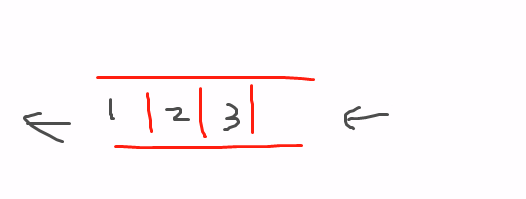
数组实现队列queue
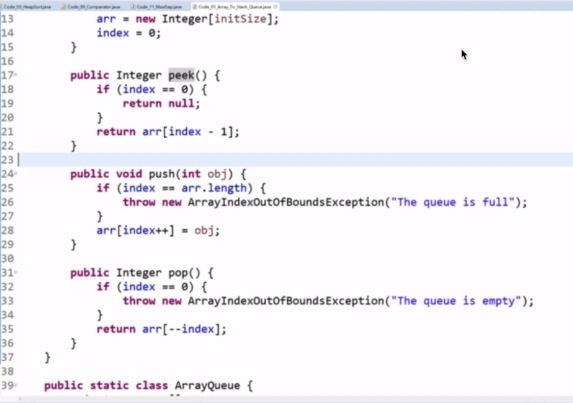
固定数组如何实现队列
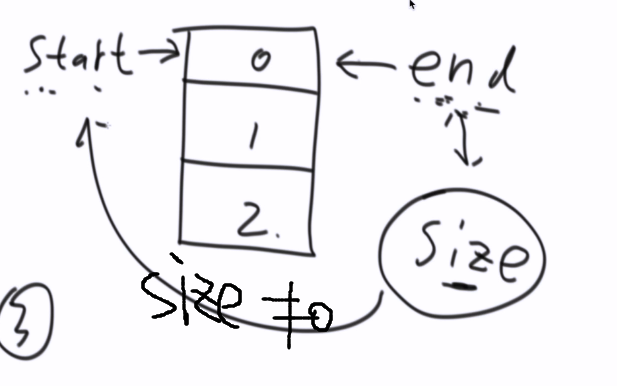
end不断循环
start追end
size解耦


题目二 实现一个特殊的栈 ,实现返回栈中最小元素的操作
在实现栈的基本功能的基础上,再实现返回栈中最小元素的操作。
【要求】
1.pop、push、getMin操作的时间复杂度都是O(1)。
2.设计的栈类型可以使用现成的栈结构。
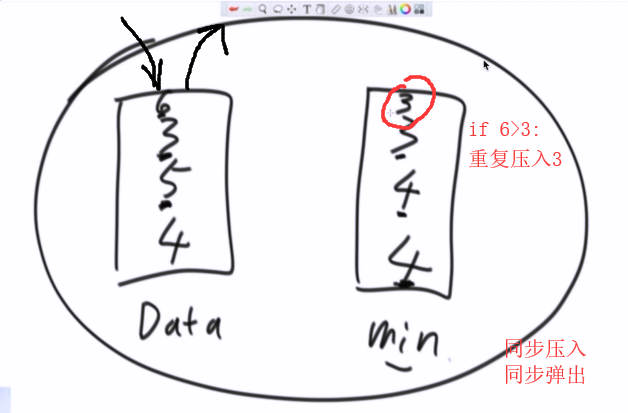

package class_03;
import java.util.Stack;
public class Code_02_GetMinStack {
public static class MyStack1 {
private Stack<Integer> stackData;
private Stack<Integer> stackMin;
public MyStack1() {
this.stackData = new Stack<Integer>();
this.stackMin = new Stack<Integer>();
}
public void push(int newNum) {
if (this.stackMin.isEmpty()) {
this.stackMin.push(newNum);
} else if (newNum <= this.getmin()) {
this.stackMin.push(newNum);
}
this.stackData.push(newNum);
}
public int pop() {
if (this.stackData.isEmpty()) {
throw new RuntimeException("Your stack is empty.");
}
int value = this.stackData.pop();
if (value == this.getmin()) {
this.stackMin.pop();
}
return value;
}
public int getmin() {
if (this.stackMin.isEmpty()) {
throw new RuntimeException("Your stack is empty.");
}
return this.stackMin.peek();
}
}
public static class MyStack2 {
private Stack<Integer> stackData;
private Stack<Integer> stackMin;
public MyStack2() {
this.stackData = new Stack<Integer>();
this.stackMin = new Stack<Integer>();
}
public void push(int newNum) {
if (this.stackMin.isEmpty()) {
this.stackMin.push(newNum);
} else if (newNum < this.getmin()) {
this.stackMin.push(newNum);
} else {
int newMin = this.stackMin.peek();
this.stackMin.push(newMin);
}
this.stackData.push(newNum);
}
public int pop() {
if (this.stackData.isEmpty()) {
throw new RuntimeException("Your stack is empty.");
}
this.stackMin.pop();
return this.stackData.pop();
}
public int getmin() {
if (this.stackMin.isEmpty()) {
throw new RuntimeException("Your stack is empty.");
}
return this.stackMin.peek();
}
}
public static void main(String[] args) {
MyStack1 stack1 = new MyStack1();
stack1.push(3);
System.out.println(stack1.getmin());
stack1.push(4);
System.out.println(stack1.getmin());
stack1.push(1);
System.out.println(stack1.getmin());
System.out.println(stack1.pop());
System.out.println(stack1.getmin());
System.out.println("=============");
MyStack1 stack2 = new MyStack1();
stack2.push(3);
System.out.println(stack2.getmin());
stack2.push(4);
System.out.println(stack2.getmin());
stack2.push(1);
System.out.println(stack2.getmin());
System.out.println(stack2.pop());
System.out.println(stack2.getmin());
}
}
题目三:队列实现栈,栈实现队列
如何仅用队列结构实现栈结构?
深度优先遍历用栈实现
面试官:用队列实现深度优先遍历,(两个队列实现1个栈)
面试官就这样贱
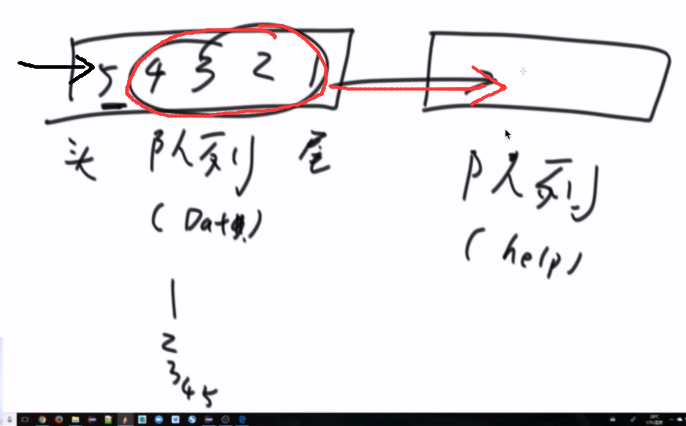
Data与Help队列交换引用
每次只能从Data队列中插入数据,或者弹出数据
如何仅用栈结构实现队列结构?
用户进data永远进push栈
取数据从pop中出
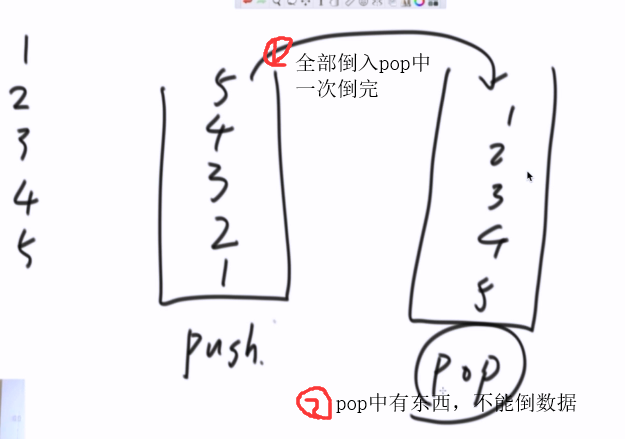
2个原则
1)一次倒完
2)pop中有东西,不能倒数据
package class_03;
import java.util.LinkedList;
import java.util.Queue;
import java.util.Stack;
public class Code_03_StackAndQueueConvert {
public static class TwoStacksQueue {
private Stack<Integer> stackPush;
private Stack<Integer> stackPop;
public TwoStacksQueue() {
stackPush = new Stack<Integer>();
stackPop = new Stack<Integer>();
}
public void push(int pushInt) {
stackPush.push(pushInt);
}
public int poll() {
if (stackPop.empty() && stackPush.empty()) {
throw new RuntimeException("Queue is empty!");
} else if (stackPop.empty()) {
while (!stackPush.empty()) {
stackPop.push(stackPush.pop());
}
}
dao();
return stackPop.pop();
}
public int peek() {
if (stackPop.empty() && stackPush.empty()) {
throw new RuntimeException("Queue is empty!");
} else if (stackPop.empty()) {
while (!stackPush.empty()) {
stackPop.push(stackPush.pop());
}
}
dao();
return stackPop.peek();
}
// 倒数据的行为
public void dao(){
if(!stackPop.isEmpty()){
return;
}
while(!stackPush.isEmpty()){
stackPop.push(stackPush.pop());
}
}
}
public static class TwoQueuesStack {
private Queue<Integer> queue;
private Queue<Integer> help;
public TwoQueuesStack() {
queue = new LinkedList<Integer>();
help = new LinkedList<Integer>();
}
public void push(int pushInt) {
queue.add(pushInt);
}
public int peek() {
if (queue.isEmpty()) {
throw new RuntimeException("Stack is empty!");
}
while (queue.size() != 1) {
help.add(queue.poll());
}
int res = queue.poll();
help.add(res);
swap();
return res;
}
public int pop() {
if (queue.isEmpty()) {
throw new RuntimeException("Stack is empty!");
}
while (queue.size() > 1) {
help.add(queue.poll());
}
int res = queue.poll();
swap();
return res;
}
// 改变help与data的引用
private void swap() {
Queue<Integer> tmp = help;
help = queue;
queue = tmp;
}
}
}
左神邮箱:chengyunzuo@sina.com